
Rachna Gilmore
Profile by Dave Jenkinson.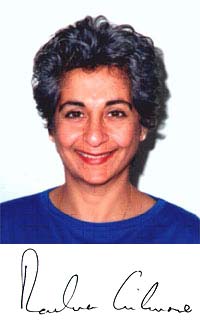
While Rachna was growing up, it was just assumed she would go into the sciences. "That's what smart kids did. Since my mother was a doctor, I thought, 'I'll be a doctor just like Mommy.' We went to the best private school in Bombay, one run by the Anglo-Scottish Education Society. My family wasn't stinking rich by any means. In that school, I wouldn't have been anywhere close to the range of the wealth that there can be, but we were certainly upper middle class. If you're upper middle class in India, you have servants, and so the gap between us and the poor was huge."
"When I was in grade four, a teacher, Mrs. Chaubal who, despite the Indian name, was actually a red-haired lady, perhaps Canadian or English, read Anne of Green Gables to us. First thing in the morning, she would gather us around her chair and read a little bit. I loved the book and was just enthralled by it. She didn't finish reading it that year, but I was a voracious reader so when I couldn't find Anne of Green Gables in the library across the road from me, or in the second hand bookstores I frequented, I spent my precious money on a new copy. I was delighted to discover there were sequels, and I bought those too. Initially, I had no idea that Prince Edward Island was a real place, but, when I did realize it, I knew that I would go there some day."
Rachna's idea of becoming a writer also found its origins in a book. "I loved Little Women and read it over and over. One day, it occurred to me, 'Hey, Jo writes stories. Maybe I can, too.' The idea just settled within me with that 'ching' of being right. Writing seemed to me to be an enormously gratifying and romantic thing to do. We lived in a big Georgian mansion that was broken up into flats. From one of the bedrooms, I could see into the veranda down below, where my best friend, Viji, lived. I remember that I stuck my head out my window and hollered for her.
'Guess what?' I shouted.
'What?' she said.
I replied, 'I'm going to be a writer when I grow up.'
She looked at me with irritation, as though I'd said something obvious and redundant. 'Yeah, I know,' she huffed."
"But, at the same time, I never really thought about how my being a writer worked with my being a doctor. Part of me thought that I couldn't or shouldn't study English because I loved reading so much. It was too much fun and, therefore, wasn't real work. I thought I had to do something serious and real, like be a doctor. But when the time came to apply to university, I decided I didn't want to do medicine. Part of my rationale then was that I didn't want a career with a life attached. I wanted a life with a career attached. I've since discovered that whatever you do pretty much takes over if you want to be successful at it. I wish I'd had better counselling then because what I should have done was study the arts. However, because you specialize very early in the English education system, all my A levels had been sciences. So when I went to university -- because I never questioned that I had to get a degree -- I studied biology."
Rachna received her B.Sc. (Hons.) in 1974 from King's College, London. "After I dithered my way through my plant sciences degree and graduated, I realized I didn't want to jump into a PhD. I wanted to travel. Partly, I think I wanted to try and find a home. I knew at this point I could not go back to India. I had changed too much, and life in India would not be right for me. I wanted to find some place where I would fit. Canada appealed to me because it seemed more open, more interesting. I had seen Pierre Trudeau on TV, and he and Canada seemed so full of energy and possibilities. Of course, I had to go to PEI because of Anne. I stayed with friends, met the man I ended up marrying, and did a B.Ed in elementary education. I didn't teach because, when I graduated, there weren't a lot of jobs available in PEI. For a while I worked as a paralegal researcher, and then I took up pottery and set up my own studio in my basement."
In 1990, the Gilmore family, now numbering four with the birth of daughters in 1980 and 1984, moved to Ottawa. "Several things led to the move. We'd lived in PEI long enough at that point for me to have itchy feet. I wanted to live elsewhere in Canada, even though I love PEI. The landscape of the island is ingrained in me, and it's 'home' in a way that no other place is. Nevertheless, it's a small place, and there was at that time in PEI, and probably still is, a fair bit of covert racism. It's not very obvious, but it's there. My older daughter, who was 10 at the time we left, had been through the school system and did experience some of that racism. However, there's a strong women's community as well as a lively arts community in PEI, and I was happier during my last years there because of those connections. Nevertheless, I felt that all of us needed to have our horizons broadened, and I wanted my children to have the opportunity to live elsewhere."
"Through all these years though, the thought of being a writer was there in the background. After I came to PEI and got my Education degree, the idea grew and grew. I jotted down stories and scribbled tales, ideas and descriptions of people. I carried a notebook around with me and talked a lot about writing but somehow I didn't and couldn't settle down to it. One day, my husband and I were walking on the beach and I was lamenting as usual, 'I've got to get down to really writing. I don't know why I'm not doing this.' Ian said to me, 'I think maybe sometimes we're afraid to start things because we're afraid we may not succeed. It's so much easier to be successful in our daydreams.'"
"That really jolted me, and I realized it was true."
"In one of the Anne books, I think Anne of the Island, there is a character, Philippa Gordon, who is extremely indecisive. She finally learns to cure this indecision by projecting what she wishes she would have done when she's 80. Thinking about that, I realized, 'I don't want to wake up one day and find I'm 80 years old and wish that I'd started to write years ago.' I was around 30 when I began to write seriously, and I think I started sending stories out to publishers in 1984-5 because my first picture book was accepted in '86. Now when I look at some of the stuff I sent out, I think, 'Did I ever have gall! Thank goodness that wasn't published.'"

"I took all kinds of creative writing classes, and one person who really influenced me was Richard Lemm who teaches in the English Department at the University of PEI. He kept saying, 'Do the best you can. Work and learn how to write really well. Don't push at getting published for now.' Of course, I wanted to be published, and so I sent out simultaneous, multiple submissions. I did my homework. I read as many children's books as I could. I researched some of the publishing houses, and, from the Canadian Children's Book Centre, I got a list of Canadian publishers that accepted unsolicited manuscripts. I targeted them all, and it was a good thing that I did. My Mother is Weird was accepted by Ragweed Press, but, because Ragweed wasn't my first choice, if I'd submitted the manuscript individually to one press at a time, it could have taken years before the book found a home."
According to Rachna, "My Mother is Weird came out of my own experience. I used to read a lot of books to my kids. It suddenly occurred to me that there were many books written about kids having bad days, but there weren't any about moms or dads having bad days, and yet, every kid watches their mom or dad have a bad day at some time. I know that an idea is worth pursuing if it gives me that charge and chill, and this one did. So I played around with it in my head. I thought it would be funny to write a story about a mom who had horns and claws and pointy teeth when she was in a bad mood. I liked that idea but didn't know where to take the story, didn't have the voice of the character, and couldn't really connect with the emotional state of the young girl. I thought about calling it 'My Mother, the Monster,' but it didn't seem quite right."
"Then one day, I was in a rush to go somewhere, and my daughter Karen, then six, was trying to talk to me. I said, 'Karen, can't you see this is not a good time? I've got horns and claws and pointy teeth. Just go away.' She shook her head, rolled her eyes and said, 'Ah Mom, you're weird.' That was it! I thought, 'It's the word I've been looking for. It's subtle, and it contains many meanings.' Suddenly I could hear this voice in my ear, 'My mother is so weird. When she wakes up, she has horns on her head and claws and pointy teeth.' I tend not to write a story until I can feel the shape of it, right from the beginning to the end and I have the voice. All of it fell into place, and so, even though I was in a hurry to go out, I stopped and scribbled it down. It was one of those few stories that actually didn't end up changing a great deal. There were deletions and tidying up, but the actual core of it remained. Partly we write to explore, or at least I do. This book may have been an exploration for me to try and understand what my daughter felt like when I was in a cranky mood. It probably came from some place within me that felt guilty about the fact that I did have cranky moods."
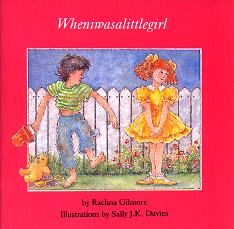
"My second book, Wheniwasalittlegirl was published by Second Story Press in Toronto. I don't know what exactly triggered the idea. I remember spending a whole day brainstorming, trying to come up with something that would be really meaningful to a kid, something that was universal in a child's life. It suddenly occurred to me that as children we often hear our parents say, 'I can't imagine why you do that. I never did that when I was a kid.' I thought a comparison involving a little girl and her mother's memories of herself at the same age could be an interesting thing to explore."
"I remember somebody saying to me after the first four books, 'She's a female Robert Munsch,' and I think I was influenced by Munsch's writing. When I decided to start writing seriously, I wanted to familiarize myself with what was out there in children's literature. I read a lot of Munsch and loved The Paperbag Princess. There are very few books that I wish I'd written, but that's one of them. I liked the way his stories were child-centred and how children were empowered. I also saw that the market needed that."
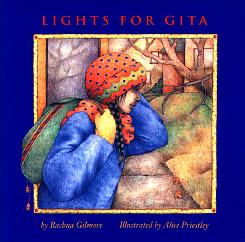
Observant readers may note a three year gap, 1991-94, in which no Gilmore juvenile titles appeared. Two circumstances were the causes. "I worked on my adult collection of short stories, Of Custom and Excise which came out in '91 and which is published under my pseudonym, Rachna Mara. It was a huge amount of work, and when I finished it, I thought, 'Of course I'm going to write some more adult fiction, but I want to keep touch with my children's fiction.' But I found it very hard to switch back. Only now am I beginning to understand why. When you write children's fiction, you have to write from a different place inside of you, from the child inside you, rather than as the adult. Writing Of Custom and Excise was a very concentrated effort, and it took a while to switch. After I finished, I was also probably just wiped out. As well, I had breast cancer twice, in '93 and in '95. That slowed things down."
Rachna's return to children's books was accompanied by a move to more cultural themes. "Writing for me is very much an exploration. I look for answers that I don't even know the questions to. Often I write to find the questions and maybe some direction to the answer. Custom and Excise was a collection of adult short fiction, women's voices, and very much set in the Indian cultural tradition. When I wrote that, it triggered and stirred up many new ideas. I think of memory as being a huge vat, and the more it is stirred, the more things burp up from the bottom. It's funny because, before writing Of Customs and Excise. I couldn't remember much about India. When you're a teenager, everything is so present. Having lived in England and then having come here, much of the Indian ethos had faded. But when the ideas surfaced, I thought it would be valuable and interesting to try and incorporate some of my Indian background into the children's fiction. That's when I thought about Lights for Gita. I didn't plan it to be a trilogy at all. The first time I wrote Lights, there was a character in it called Mr. Flinch who was the mean old landlord of Gita's apartment. He played a part in dampening the Divali festivities by objecting to the diyas that Gita's family had lit. When my editor saw it, she said, 'That's fine, but I don't really think Mr. Flinch needs to be here. It's the light and the dark that's far more interesting. It's a tiny perfect moment.' I thought about it and eventually agreed with her, so I re-wrote Lights for Gita without Mr. Flinch. But he continued to hang around and because I was interested in Gita and wanted to show her moving on, I wrote Roses. And of course, Mr Flinch insisted on being in that book"
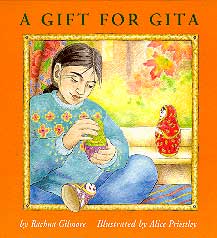
"The Gita books don't reflect my experience of going to England. When I think back on it now, it was hard going from India to England, but I don't think it was any harder because it was a different country. I didn't have to deal with another language. At that age, it's hard to move anywhere. I remember missing my friends but not having Gita's wrenching desire to go back. However, I wanted to be true to this character, and I didn't want to prettify her experience. For Gita, the move was bittersweet -- there was loss and gain. Eventually, to have Gita come to some understanding of where home is, I felt that I needed to write a third story."
From picture books, Rachna moved to juvenile chapter books. "The original idea for A Friend Like Zilla came to me as an image when we were by a lake in Gatineau Park and my kids were feeding seagulls. I suddenly had an image in my head of two girls, one much older than the other, feeding the gulls, and I had a visceral sense of their connection as being very close and special. I didn't know who they were, and so on the drive home I explored and dug around. When I fleshed it out some more, I came up with Zilla. At first I tried to write Friend as a picture book, but it just didn't work because the characters, Nobby and Zilla, were doing too many things for a picture book. I finally realized that it was not a picture book, so I re-wrote it as a novel and set it in PEI."
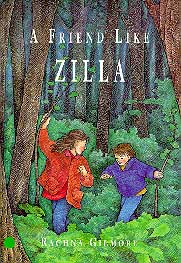
In A Friend Like Zilla, one of the characters is developmentally delayed. Following Rachna's normal writing pattern, "initially, it was the imaginative leap, and then the research was done. I talked to several people who were involved with developmentally delayed teenagers to see what they'd be like. I wanted to see where Zilla fit into the spectrum, and basically I think she would be considered to be mildly developmentally delayed. I've included some things that some people might say aren't accurate to a person in that situation. For instance, one person I talked to said that it was unlikely Zilla would leave a white milk mustache when she drinks because she would be taught to be very methodical in her routine activities. I thought about the comment and concluded, 'She's agitated because Uncle Chad has been bugging the girls, and she's been thrown off keel.' So I kept the incident the way I'd written it."
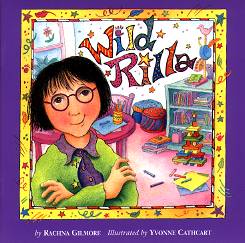
"I got the idea for Wild Rilla in the middle of the night. I think that each book is, to a certain degree, a reflection of what's happening in your life at the time. When I think about it now, it was around the time I had cancer, or was recovering from cancer. Probably, at some level, I felt as though I'd been put in the corner by the illness that was curtailing my life, and I didn't want to stay there. The character, Wild Rilla, suddenly came to me, and a rhyme began to play in my head. I thought, 'I'd better write this down.' If it's just an idea or a feeling, I can lock it in, but, if words and phrases come and if I don't write them down, I risk losing them. And very often, the words are a key to opening the door to the story and the voice of the character. My husband was asleep, but I always keep a pencil or pen on my bedside table. The only scrap of paper I had was a sales receipt, and so I tiptoed to the bathroom, turned on the light, jotted down a few ideas and came back to bed. The next day, I developed it further."
"A Screaming Kind of Day began with a conversation with somebody about how we tend to regard children with disabilities in terms of what they can't do, rather what they can. "It occurred to me that when you're a child, everything is so present in your life. It's the 'truth,' and it's just a given. As I was driving home, this character, Scully, came to me, and she came with a name, which doesn't usually happen. Usually I have to hunt around for the name, and often I use a book of baby names to find the right one. Scully was vibrant and interesting, and I knew she was nobody's fool. She was going to use her hard-of-hearingness to her advantage. I came home and made some notes. One of the things I recall writing was, 'Mother has a great sense of humour, and she has enormous respect for Scully. Will not let Scully get away with anything.' I jotted down some ideas, and then I wrote part of the story. I started off thinking about Scully going 'gargle-argle-argoyle' and making faces, but that didn't seem to go anywhere. I love the sound of it though and will probably use it in another story. Exploring further, I had a sense of how intensely this child felt, and then I remembered how, when my daughter was little and we lived in PEI, we used to go for rainy day walks, and how much I loved them. When it's wet, the woods are all hushed, quiet, and the green is so bright, intense and vibrant that it just leaps off the trees and screams at you. I wanted to capture that connection, that delight, and so I wrote that part, and then the beginning about why she wasn't allowed to go out in the rain. Initially, I thought Scully may have a cold or something."
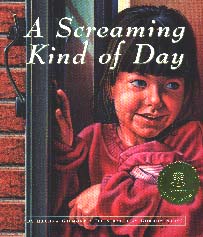
"When I write a story, I always do the research afterwards because I want the creative leap of the imagination and its truth to come first. Only then can I do the research and see where it fits. I don't have anybody in my life who is hard-of-hearing so I contacted organizations connected with hard-of-hearing children and talked back and forth to get the facts right. Initially, I had Mom and Scully signing as well, but that changed because the organizations I spoke to said it's rare for somebody to be integrated into the speaking world and also sign. It does happen, but mostly people who sign become part of what we call the deaf culture; the signing becomes the main form of communication and they tend not to vocalize. I was told that a large group, in fact the majority, prefer not to have their children learn signing because they believe that it may inhibit them from integrating with the hearing world. After the research, I fixed the parts of the story that needed changing, and I made sure that people who have hard-of-hearing children saw the story and gave me feedback."
"Gordon Sauvé did the art, and while I have talked to him on the phone, we've never met. He said he was in church one Sunday and noticed a young girl he thought would be perfect for Scully, and so he approached her parents for permission. After he photographed her, he realized she had a brother who was right for Leo, Scully's brother. Eventually, he used the whole family. My publisher, Gail Winskill, had quite specific ideas about how the art should proceed. For example, she didn't want the mother's face to show until the end of the story. Gail said, 'That mother is really mad, and we don't want to show that.' I think that's partly why Gordon developed the perspectives that he did with the close-ups of faces and hands and feet."
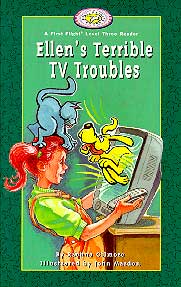
"The 'First Flight Chapter Books,' Fangs and Me and Ellen's Terrible TV Troubles were both stories I'd written years ago, but which didn't quite work the way they were. I liked the story of Fangs and Me, but it wasn't right as a picture book story. I remember an editor suggesting that I write it as a chapter book, but I didn't agree at the time so I put it away. A while ago, as I took a break from some larger project, I looked though some of my old stories. At the time, Fitzhenry & Whiteside was publishing a series of early readers, and I realized that Fangs and Me would be perfect in that form. The story was there, and all it needed was some plot development and the fleshing out of characters. The same thing happened with Ellen's Terrible TV Troubles. It was even easier in many ways because it was right for that format and only needed to be broken up in appropriate segments, apart from some fine tuning. It was great to be able to use some old stories that I really liked and had never gotten around to polishing. I still have stories that I think would be right for that series. Every now and again, I bring something out and play with it."
"I don't like spiders, but the first idea for Fangs and Me came way back when I was driving Karen to kindergarten. I was car pooling with a neighbour and her son. When my neighbour asked Karen what she had for 'Show and Tell,' Karen proudly held out a honey jar with a spider in it. My neighbour smiled shakily and responded, 'Ohhh. Nice.' Afterwards, she told me, 'I can't stand spiders, but I didn't want to say anything because kids don't have this 'ick' factor about bugs until they hear it from adults.' That was the trigger for the story. For my spider research, I called lots of people, but eventually via phone I found a wonderful gentleman, Dr. Charles Dondale, who was an absolute treasure. He knew so much about spiders, not just textbook details, but also the kind of lore that I wanted. He talked about how you would get to do the 'yo-yo' with a spider, and how to gently tap a spider off the web so that you don't hurt it. If I hadn't talked to him, the book wouldn't have been 'real' at all."
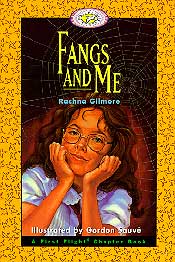
"Mina's Spring of Colours came partly as an offshoot of the Gita books. I wrote it in the middle of writing some drafts of A Group of One, a YA novel with an Indian context. Actually I've been working on Group for years and years. It's a story about a family of three daughters. Tara, the oldest, is 15. The family lives in Canada, and the parents, particularly the mother, are very westernized, although both were born in India. The story is about what happens in their lives when Tara's paternal grandmother, whom she's never met, comes to visit them. The grandmother is very Indian and was involved in the Indian independence movement; she has always been resentful of her son's choosing to leave India."
"But back to Mina. When I was writing the second Gita book, I explored doing something about the festival of Holi, a wonderful spring holiday that involves people spattering each other with coloured water and powders. When I went back to look at my old notes, I had written down something like 'Gita's Spring of Flowers.' I liked the idea enough to want to work with it. Holi is such an exuberant holiday, and I wanted a story that would reflect and echo the meaning of the festival, which is actually about forgiveness, not revenge. What pushed me to get on with it was a grant from Canadian Heritage. Without the grant, it still would have been done, but it may have waited until after A Group of One came out.
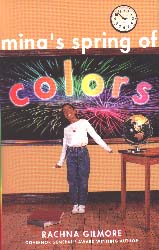
"I don't want Mina, the Gita books and Group of One to be considered to be ethnic literature, or minority literature. I think that the Gita stories, for instance, are universal. So many of us in this day and age move away from our core families. We leave our grandparents, and there are always changes and adjustments. I want these books to be seen as universal stories and also as part and parcel of the Canadian experience because we, this new wave of immigrants, are part of the evolving Canadian experience. I would like all children to identify with Mina's Spring of Colours and to enjoy it, and not merely to see it as a book that teaches you about the effects of racism. How deadly!"
Describing her writing habits, Rachna says, "In my perfect world, I get up early, get dressed, sit for meditation, have my breakfast, and then I go down to my study and work for several hours. I finish off around mid-to-late afternoon and then go for a walk to come down to earth, and then get groceries or whatever. This isn't always how it works. I find January and February difficult. I think part of it is seasonal affective disorder, but also I miss green growing things. With winter, the more physical space the snow takes, the more you shrink into yourself. I'm not as focussed in January and February, and I just have to be a little bit more flexible. What I try to do is to work every day. Because I'm really good at procrastinating, I say to myself, 'OK, I'm going to my study. I don't have to work more than one hour. That's it. I just have to make sure that the hour is a good one.' And that usually works because once I get caught up in the story I don't want to stop. Very often, I end up working really late, and then I'm tired the next day."
"Generally speaking, especially with a picture book story, there are three things I like to have in my head before I start to write. First, I want to have the shape of the story, a satisfying emotional arc, a feeling that it works well. Second, I want the voice of the character, and third, I want to know that character, and to know her feelings. When I have those three things, then I can start to write the story. Often I think I know what's going to happen next, only to have it change. That's fine. I can trust that. When I write a novel, I have a general idea of where it's going, but sometimes it changes completely. With A Group of One, for instance, I kept getting it to the point where the grandmother arrived, and I didn't know how to take it further. I had several versions of what happened afterwards, and I had to play around and find the true version. It wasn't until I did my research on the Indian Independence Movement that I understood who the grandmother was and really knew where the story needed to go. The grandmother was 14-years-old when she became involved with the Quit India Movement, and it had a huge impact on who she was. It was hard to do that research. It was painful in many ways because some of the things that happened were pretty horrific."
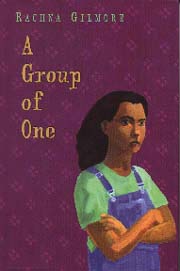
"I'm actually pleased that A Group of One is my first book in the US because one of the things that Canadian publishers tend to say, and which I find grating, is that you can't have references to Canada in your books because they won't sell in the US. A Group of One makes references to Canada, and the word "Canada' occurs throughout. It has a very strong Canadian context and in many ways addresses a concept of identity that is uniquely Canadian. I was concerned about Holt wanting to change those references, but it was never an issue, and so the Canadian context is still present and fundamental to the book."
Reflecting on being awarded a Governor General's Literary Award for A Screaming Kind of Day, Rachna remarks, "I'm really lucky I didn't get a GG earlier because it could have really messed me up. By the time I got it, I'd done enough writing to have learned something about the craft of writing, but also to know that I wasn't a better writer because of the award. There was no sense of being puffed up; I knew I was the same writer that I was before, and that I still had much to learn. But of course there have been positive outcomes. My books get more attention, and so Mina was reviewed faster, I think, than if I hadn't won the GG. As well, my name is a little more recognized now, which I hope will improve sales for all my books, even the old titles."
"If there's a third positive outcome, it has something to do with faith. I don't mean faith as in God, but 'faith' as in trusting that your life is progressing the way it should, and trusting yourself to choose the right directions. I realized that part of having faith was learning to accept life's ups and downs. Although I had accepted the hard and difficult things in my life, I had a hard time accepting the GG, and I needed to accept it, too. Doing that gave me a bit more confidence. Having your peers think that your work is reasonably good is a huge honour, and I felt joyful satisfaction in the realization that I had indeed taken the right paths and made the appropriate choices in pursuing writing."
In considering how her writing has changed, Rachna observes, "I think I have a clearer sense of the craft of it now. I also have a better sense of the kind of story I want to write. It's the kind where the story is first and foremost and the author is invisible. I'm interested in exploring characters and the psyche of characters, the inside story, not just the surface. I think I'm better at delving into the complexities of characters than I was, and I understand some of the mechanics of developing character, and how it impacts on everything else. I think I'm also more playful about exploring the poetry of words."
"Perhaps my writing has also changed in terms of leaving things behind. I talked a lot about family relationships in some of my early stories, maybe because it was something I was exploring. I've done a lot about the Indian cultural community, and I probably will continue to do some of that, but I don't feel the same urge to do that as much. Now, the ideas that come to me seem to be more in the world of fantasy. In fact, I'm working on a novel right now that I'm quite excited about. I think it's going to be for grades 3-5. It's called 'Calantha and the Sower of Tales.' It's a fantasy, something very different from the kinds of stories I've written so far. It's delightful to be exploring new areas and to feel new creative channels open up."
"I would also like to get back to adult writing, but right now the stories that come to me are the children's ones. There are so many reasons why I love writing children's fiction. First of all, I find children's books, the good ones, often delight me more than adult fiction does. I like to write books that delight, and today what seems to be successful and critically acclaimed literary fiction is work that's often bleak and full of grotesqueries. I'm an optimistic person, and I like to project that in my work. L.M. Montgomery said it well in one of her journals when she talked about how she was criticized for portraying just the sunny side of life. She observed that other writers only look at the pigsty. I think that's quite true, but there's something in the middle -- you can be in a pigsty, but when you look up, the stars are still there. I believe in evolution in that, as individuals, as spiritual beings, we strive to improve ourselves, to grow meaningfully. Life is a bit like writing a story -- it's dead ends and wrong turnings, but it's moving on and finding your way through. It isn't about not making mistakes, but rather about making them and still learning and moving on. I want to have that sense of hopefulness in my literature. I'm learning a lot from writing children's books that's going to be very useful to me when I go back to writing adult fiction. I think my next adult fiction will probably be quite different from what I've done."
Books by Rachna Gilmore.
- My Mother is Weird. Ragweed, 1988. Preschool-grade 2
- Wheniwasalittlegirl. Second Story Press, 1989. Preschool-grade 2.
- Jane's Loud Mouth. Ragweed, 1990. [OP]. Preschool-grade 2.
- Aunt Fred is a Witch. Second Story Press, 1991. Preschool-grade 2.
- Lights for Gita. Second Story Press, 1994. Preschool-grade 2
- A Friend Like Zilla. Second Story Press, 1995. Grades 3-5.
- Roses for Gita. Second Story Press, 1996. Preschool-grade 2.
- Wild Rilla. Second Story Press, 1997. Preschool-grade 2.
- A Gift for Gita. Second Story Press, 1998. Preschool-grade 2.
- A Screaming Kind of Day. Fitzhenry & Whiteside, 1999. Preschool-grade 3.
- Fangs and Me. Fitzhenry & Whiteside, 1999. Grades 3-4.
- Ellen's Terrible TV Troubles. Fitzhenry & Whiteside, 1999. Grades 2-4.
- Mina's Spring of Colours. Fitzhenry & Whiteside, 2000. Grades 3-5.
- A Group of One. Henry Holt, 2001. Grades 6-9
Adult Fiction (As Rachna Mara)
- Of Custom and Excise. Second Story Press, 1991.
This article is based on an interview conducted in Ottawa, February 16, 2001.
Visit Rachna's home page at http://www.makersgallery.com/gilmore
